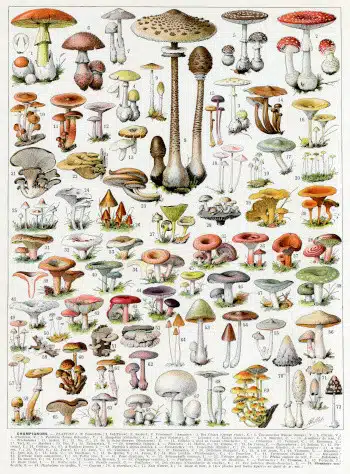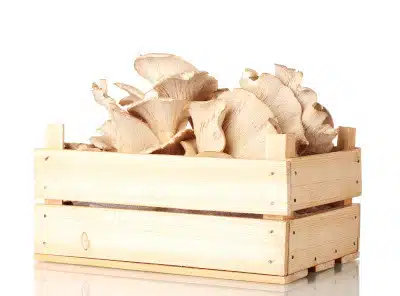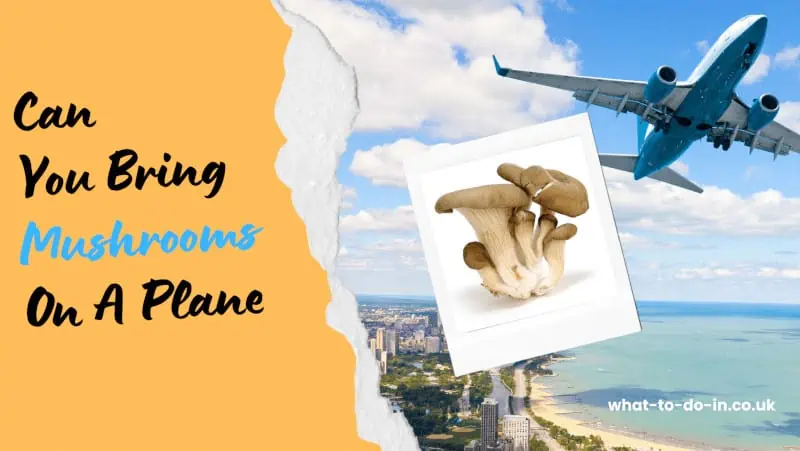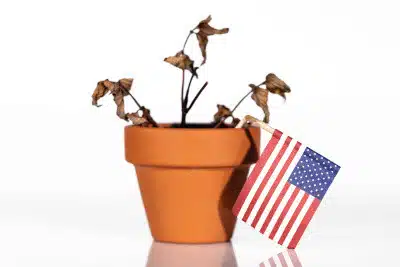Air travel often comes with its own set of rules and regulations, especially when it comes to carrying food items like mushrooms. Whether you’re a culinary enthusiast wanting to bring a rare variety of mushroom from your travels or simply wish to enjoy your favorite mushrooms at your destination, understanding the do’s and don’ts of taking mushrooms on a plane is crucial.
Factors such as the type of mushroom, its preparation and packaging, and the specific rules of the airline and destination country all come into play. This guide will provide valuable information on the ins and outs of successfully and legally bringing mushrooms on your flight, ensuring a hassle-free journey.
Can You Bring Mushrooms on a Plane?
When it comes to packing items for air travel, it is important to be well-informed about what you can and cannot bring on a plane. This is especially true when it comes to food items, such as mushrooms.
USA Domestic Flights
In general, it is permissible to bring mushrooms on a domestic flight within the USA. However, there are a few key considerations you should keep in mind:
- Solid Food Items: According to the Transportation Security Administration (TSA), solid food items can be transported in either your carry-on or checked baggage. This means that fresh, whole mushrooms should not present an issue.
- Preparation Matters: How your mushrooms are prepared could have an impact on their acceptability. For example, mushroom dishes such as stews or sauces might be considered liquids or gels, and therefore subject to the 3.4 ounce rule for carry-on luggage.
- Packaging: It’s recommended that food items be properly packaged. A spill or leak could not only ruin your other belongings, but also cause issues during the security screening process.
- Local Laws and Regulations: Some states have laws and regulations about the transportation of certain foods. It’s always a good idea to check local laws if you’re uncertain.
International Travel
The rules can change when it comes to bringing mushrooms on an international flight, due to the potential for certain foods to carry diseases or pests. Here’s what you should know:
- U.S. Customs and Border Protection (CBP): When returning to the USA from an international destination, you must declare all food products. Failure to do so can result in fines of up to $10,000.
- Importing Mushrooms: Certain types of mushrooms may be prohibited from being brought into the U.S. due to the risk of foreign pests and diseases. Always check the CBP’s guidelines before you pack.
- Country-Specific Regulations: Each country has its own rules and regulations about what food items can be brought in. Some may have restrictions on certain types of mushrooms or food items in general.
- Preparation and Packaging: Similar to domestic travel, the preparation and packaging of your mushrooms could impact their acceptability. Dishes that could be classified as liquids or gels may be subject to restrictions.
https://www.tsa.gov/travel/security-screening/whatcanibring/items/fresh-fruits-and-vegetables
Flying with Mushrooms Internationally

Generally, most countries allow the import of commercially cultivated mushroom species, such as button mushrooms, portobello, shiitake, and oyster mushrooms, especially if they are processed (canned, dried, etc.). However, wild mushrooms, rare species, or species not native to the destination country may be subject to restrictions.
Please note that the importation rules can change based on current agricultural risks and threats, so it’s always a good idea to check with the appropriate agricultural or customs authority of the country you plan to visit.
For example, the United States Department of Agriculture (USDA) and the U.S. Customs and Border Protection (CBP) provide up-to-date information about importing food items into the United States. Similarly, the Australian Department of Agriculture, Water and the Environment provides information about what can be brought into Australia.
General Guidelines for Traveling with Mushrooms
Regardless of the country you’re flying to, there are several common guidelines to consider:
- Fresh vs. Processed: Generally, processed mushrooms (canned, dried, etc.) are more likely to be accepted than fresh mushrooms, as they pose less risk of carrying pests or diseases.
- Packaging: Proper packaging is important. Mushrooms should be securely packed to prevent leakage, spoilage, or contamination.
- Customs Declaration: Always declare all food items upon arrival. Failing to do so can lead to penalties or confiscation of the items.
Traveling to Specific Countries with Mushrooms
Different countries have different regulations regarding food importation. Here are some general guidelines for a few popular destinations:
USA
The U.S. Transportation Security Administration (TSA) provides guidance on traveling with food. You can find information on their website.
UK
The UK government provides information on what food you can bring into the UK on their official website.
European Union
The European Commission provides information on plant health and biosecurity, which includes rules on mushrooms. More information can be found on the EU’s official website.
- Fresh and dried mushrooms are generally permitted.
- Mushrooms must be for personal use, and the quantity should reflect this.
- You should declare your mushrooms at customs upon arrival.
Australia
The Australian government provides information on what food you can bring into Australia on their official website.
- Australia has strict biosecurity laws. Fresh mushrooms are likely to be prohibited.
- Processed mushrooms (cooked, canned, dried) are generally allowed, but must be declared at customs.
New Zealand
The Ministry for Primary Industries in New Zealand provides information about what foods are allowed into the country. You can find more details on their website.
Canada
The Canadian Food Inspection Agency provides guidance on what food you can bring into Canada. More details are available on their website.
- Fresh, dried, and canned mushrooms are generally allowed from most countries.
- Mushrooms must be free from soil, pests, and diseases.
- Always declare food items at customs.
Japan
The Ministry of Agriculture, Forestry and Fisheries provides information about what foods you can bring into Japan. More information is available on their website.
- Japan allows the import of dried mushrooms, but fresh mushrooms are typically not allowed due to quarantine regulations.
- All food items must be declared at customs.
Singapore
The Singapore Food Agency provides information about what foods you can bring into Singapore. More details are available on their website.
India
- India generally allows the import of dried mushrooms. Fresh mushrooms may be subject to restrictions.
- All food items should be declared at customs.
Please ensure you check with the country you are flying to before transporting mushrooms and other fungi. We have collated a list of government websites for you to check before you fly to make your life a little easier.
Further Considerations
- Check the Rules: Always check the specific import rules of your destination country before packing food items.
- Professional Assistance: If you’re uncertain or if you’re carrying a large amount, it may be beneficial to consult with a customs broker or similar professional.
- Mushroom Species: The type of mushroom can also impact its acceptability. Certain countries may restrict specific species due to local flora and fauna preservation laws.
Remember, while traveling with mushrooms, the key to a hassle-free experience lies in understanding and complying with the food import regulations of your destination country.
How to Pack Mushrooms in Your Luggage

Preparation before Packing
Before you start packing, you need to consider a few things:
- Check the Condition: Only travel with mushrooms that are in good condition, without any signs of spoilage.
- Clean the Mushrooms: It’s recommended to clean your mushrooms before packing to remove any dirt or debris, as this can affect their quality during travel.
- Consider the Species: Some species of mushrooms are more delicate than others. Consider packing more robust varieties, such as Portobello or Shiitake, when traveling.
Packing Mushrooms in Carry-On Luggage
If you’re packing mushrooms in your carry-on luggage, follow these steps:
- Use Suitable Containers: Use firm, airtight containers to protect your mushrooms from damage and contamination.
- Avoid Overpacking: Do not overfill the containers. Mushrooms need some space to avoid being crushed.
- Secure the Containers: Make sure the containers are properly sealed to prevent leaks and odors.
- Pack Strategically: Place the containers in your luggage where they’re less likely to be squished, such as in the middle surrounded by softer items.
Packing Mushrooms in Hold Luggage
For mushrooms being packed in your hold luggage, follow these guidelines:
- Use Sturdy Packaging: Because hold luggage can be roughly handled, use sturdy, airtight containers to store your mushrooms.
- Use Padding: Protect your mushrooms from bumps and jostles by padding the container with clothes or other soft items.
- Avoid Extreme Temperatures: Try to insulate your mushrooms from extreme temperatures, as the hold can become very cold or hot.
- Secure the Containers: As with carry-on luggage, ensure that the containers are properly sealed to prevent leakage and the spread of odors.
Special Considerations for Dried Mushrooms
- Use Vacuum Sealing: Vacuum-sealed bags are a great option for dried mushrooms as they save space and prevent moisture intrusion.
- Label the Bags: Label the bags clearly to avoid confusion at customs.
Remember, while packing mushrooms for travel, the key goal is to maintain their quality while ensuring that they are stored in a manner that adheres to airline regulations. Properly packed mushrooms will be a delicious addition to your meals once you reach your destination.
Guidelines for Bringing Plants on a Plane
Traveling with plants can add an extra layer of complexity to your journey, given that both airlines and countries have specific rules regarding their transportation. This guide aims to provide a general understanding of which plants you can and cannot bring on a plane. However, due to the complexity and variability of these regulations, it is always advisable to consult the airline’s policies and the agriculture or customs department of your destination country.
Plants You Can Bring on a Plane
- Houseplants: Small, potted houseplants are generally allowed in carry-on luggage if they fit under the seat or in the overhead compartment. However, they must be free from pests and diseases.
- Cut Flowers: Cut flowers without soil are usually allowed on planes in both carry-on and checked luggage, though restrictions may apply if the flowers are an endangered species or are from certain countries.
- Succulents: Small succulents can typically be transported on a plane if they’re in a small container that fits in carry-on luggage. They should be free from pests and diseases.
Plants You Cannot Bring on a Plane
Large Plants: Due to size restrictions, large plants that cannot fit in the carry-on or checked luggage are usually not allowed on a plane.
- Soil: Soil can harbor pests and diseases and is often restricted, especially for international flights.
- Endangered Species: Plants listed as endangered under the Convention on International Trade in Endangered Species (CITES) are prohibited from transport without the proper permits.
- Certain Plant Species: Some plants may be considered invasive species or potential carriers of pests and diseases in certain countries and are therefore restricted.
International Travel with Plants
When traveling internationally with plants, additional rules apply due to the potential risk of spreading pests and diseases. You are generally required to declare any plants, seeds, and plant products upon arrival. They may be subject to inspection, and in some cases, a phytosanitary certificate is needed to prove that the plant is free from pests and diseases.
It’s worth noting that rules can vary significantly from one country to another, so it’s critical to check the regulations of your destination country. Some countries have strict prohibitions or restrictions on certain plant species, while others may require plants to undergo quarantine upon arrival.
Sources:
- Transportation Security Administration (TSA): Traveling with Plants
- United States Department of Agriculture (USDA): Traveling with Plants
- Convention on International Trade in Endangered Species of Wild Fauna and Flora (CITES)
FAQ’s for Taking Mushrooms on a Plane
Traveling with mushrooms on a plane often raises numerous questions due to varying international customs and airline regulations. Common FAQs include inquiries about which types of mushrooms are permissible for air travel, the rules about packing mushrooms in carry-on versus checked luggage, and how to properly declare food items at customs. Additionally, passengers often ask about the differences in regulations between domestic and international flights, the implications of carrying fresh versus processed mushrooms, and the specific guidelines for mushroom importation into certain countries. Understanding these nuances can help ensure a smooth travel experience and allow you to enjoy your favorite mushrooms, no matter your destination.
Can I take fresh mushrooms in my carry-on luggage?
Yes, you can generally take fresh mushrooms in your carry-on luggage for domestic flights within the U.S., according to the TSA. However, rules may vary for international flights.
Can I pack mushrooms in my checked luggage?
Yes, mushrooms can be packed in checked luggage for both domestic and international flights. Make sure they are well packaged to avoid damage and spoilage.
Are there any restrictions on the type of mushrooms I can bring on a plane?
Most commercially available mushrooms are fine to bring on a plane. However, some countries may have restrictions on certain species, especially for imported mushrooms. Always check the rules of your destination country.
Do I need to declare mushrooms at customs?
Yes, for international flights, you need to declare all food products, including mushrooms, when entering a new country. Failure to do so can result in fines.
Can I bring mushroom dishes, like mushroom soup, in my carry-on?
Liquids, aerosols, and gels are subject to the 3-1-1 liquids rule by the TSA, so mushroom dishes classified as liquids should be in containers of 3.4 ounces or less and all containers should fit in one quart-sized plastic bag.
Can I bring dried or canned mushrooms on a plane?
Yes, dried and canned mushrooms are generally easier to travel with and are usually allowed both in carry-on and checked luggage.
What’s the best way to pack mushrooms in my luggage?
Use a firm, airtight container for fresh mushrooms and consider vacuum-sealed bags for dried mushrooms. Place them in your luggage where they’re less likely to be squished.
Are there any specific rules for taking magic mushrooms on a plane?
Magic mushrooms, also known as psilocybin mushrooms, are classified as a Schedule I controlled substance in the U.S. and are illegal in many countries. They should not be taken on a plane.
Can I bring truffles on a plane?
Truffles, another variety of fungi, are generally treated the same way as mushrooms. You can usually bring truffles on a plane, but always check the specific rules of your airline and destination country.
Does the quantity of mushrooms I bring on a plane matter?
The quantity should reflect personal use, especially when traveling internationally. Large amounts may raise suspicions of commercial intent, which could lead to additional inspections and potential confiscation.
Packing Up – Flying With Mushrooms
Navigating the world of air travel with mushrooms can seem daunting at first glance, but with a grasp of the relevant guidelines, it’s perfectly manageable. In essence, both carry-on and checked luggage can generally accommodate mushrooms. Fresh, whole mushrooms are usually permissible for carry-on luggage, as long as they’re properly packaged to avoid spills and contamination. Liquids or gels, including certain mushroom dishes, might be subject to the 3.4 ounce rule for carry-on luggage.
When it comes to packing mushrooms in your hold luggage, a priority is ensuring their secure packing in firm, airtight containers. Given the rough handling that checked luggage can often endure, sturdy containers and strategic packing can protect the mushrooms from damage.
The regulations can change when traveling internationally due to biosecurity measures, so it’s always important to check the customs rules of the destination country. Understanding these key distinctions can ensure that your mushrooms reach your destination in prime condition, ready for your culinary adventures.


 Large Plants: Due to size restrictions, large plants that cannot fit in the carry-on or checked luggage are usually not allowed on a plane.
Large Plants: Due to size restrictions, large plants that cannot fit in the carry-on or checked luggage are usually not allowed on a plane.


